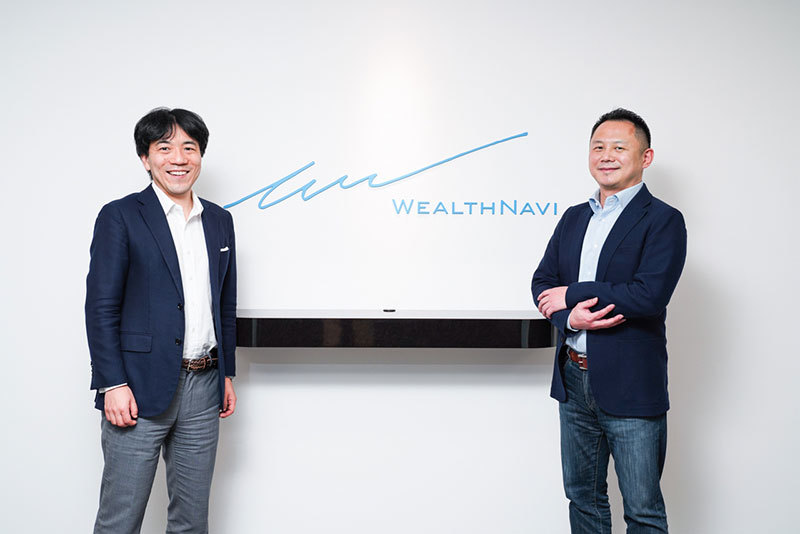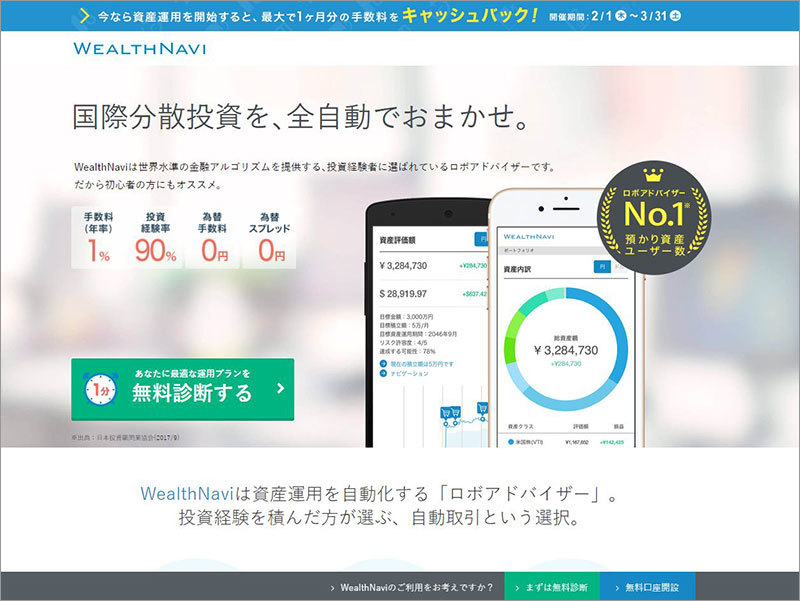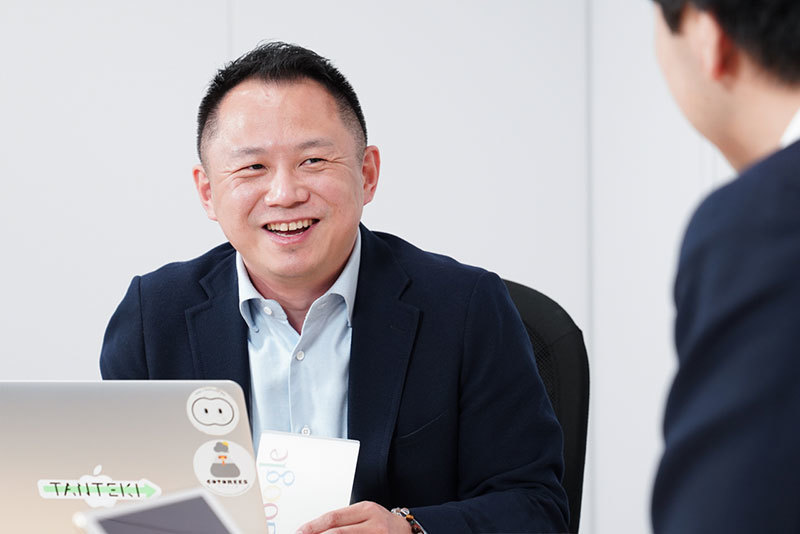Note: This website was automatically translated, so some terms or nuances may not be completely accurate.
Fully automated international diversified investment. How to build "trust" in new money services.

Kazuhisa Shibayama
WealthNavi Inc.

Nakajima Fumihiko
Dentsu Inc.
Robotic advisors (robo-advisors) automatically manage assets entrusted by users. This service sector is gaining attention as the Financial Services Agency promotes the shift "from savings to asset formation," actively supporting individual asset building through new systems like iDeCo (individual-type defined contribution pension) and NISA (Nippon Individual Savings Account). WealthNavi is achieving rapid growth in this field.
Such new financial services face significant hurdles in gaining consumer trust. How should one build "new trust" in an unprecedented business? Fumihiko Nakajima of Dentsu Inc. CDC, which focuses on developing new businesses and supporting corporate ventures, particularly in technology, interviewed Kazuhisa Shibayama, CEO of WealthNavi.

What We Did to Balance Growth "Speed" and "Trust Building"
Nakajima: At Dentsu Inc. CDC, I lead the Future Business Tech Team. Under the theme of "creating the near future," we're heavily involved in activities to build new industries, including discovering startups, investing, and joint ventures. For Web Dentsu News, I've also interviewed many companies and investors, focusing on new industries. This time, I'd very much like to hear your thoughts, Mr. Shibayama, on "building credibility and trust to grow new industries."
Shibayama: Building credibility and trust is indeed a crucial theme. It's something we've always prioritized, and conversely, I'd love to hear your perspective.
Nakajima: Now, within the fintech world where new services emerge constantly, robo-advisors are particularly showing remarkable growth. They're services that automatically manage assets based on financial algorithms, tailored to your target amount and risk tolerance, right? "WealthNavi" launched its service in July 2016 and, as of the end of September 2017, became Japan's largest robo-advisor (※).
※According to the Japan Investment Advisers Association. #1 in assets under management and #1 in number of users.
Shibayama: Thank you. However, we want more people to recognize "WealthNavi" and "robo-advisors" in general. One online survey showed awareness of robo-advisors is only around 20%. Even so, assets under management grew from about ¥1 billion at the end of 2016 to nearly ¥50 billion by the end of 2017. I feel we are overcoming the most difficult phase for a new service: "expanding from zero awareness."
Nakajima: What I want to discuss today is precisely that—how to expand a service starting from zero awareness. At Dentsu Inc., I support startups and new business development for major corporations. New services inevitably face high hurdles before gaining public recognition. For startups, growth speed is crucial, but for a new service—especially one involving money—earning user trust is paramount. These two goals, "growth speed" and "trust acquisition," can seem contradictory. How did you tackle this challenge?
Shibayama: One thing I can say is "avoid overextending yourself in every aspect." While aiming for rapid service growth, the key is how thoroughly you can avoid overextending. WealthNavi never overextended itself from launch, instead building steadily through persistent trial and error.
Nakajima: Where does that approach manifest itself?
Shibayama: First, the technology and investment theory underpinning WealthNavi's service are mostly orthodox, established technologies – what you might call "mature technologies." Combining these creates a cutting-edge service, but we deliberately avoided using the absolute latest in each individual component.

Nakajima: So WealthNavi combines stable technologies whose usefulness in the market has already been proven. Building solely with well-established technologies led to developing a service that "doesn't overreach," right?
Shibayama: Another factor crucial for gaining user trust was setting the "minimum investment amount" (the lowest asset threshold users must deposit to use the robo-advisor service). At launch, WealthNavi set this minimum at 1 million yen.
Nakajima: At the time, 1 million yen was quite a high threshold compared to other robo-advisor services, right?
Shibayama: That's right. But I think it was beneficial. Setting the minimum at ¥1 million meant that initially, few investment beginners used the service, and experienced investors made up about 90% of our users. Consequently, user expectations for the service naturally became high. As we worked to meet those expectations, the service quality steadily improved.
Within the first six months after launch, we stabilized the system, improved the account opening process, and introduced a savings plan service. Once the quality reached a level where it gained solid user support, we then began lowering the minimum investment amount to appeal to novice investors.
Nakajima: So you refined the product while listening to early adopters' requests, then expanded the service in step with the growing trust it earned.
Shibayama: Yes. Six months after launch, we lowered the minimum to ¥300,000, then gradually reduced it further to ¥100,000. Now, through integration with " Mametasu "—a service that channels spare change into WealthNavi investments—the minimum investment is ¥10,000. We steadily elevated service quality, gradually built trust, and broadened our user base.
Nakajima: So, in both "technology used" and "service expansion," you truly avoided "overreaching."
Shibayama: And similarly, there are things we're tackling incrementally even now. I believe these efforts will blossom into the next stage of growth. I hope we can continue growing steadily through this iterative process.
The team structure driving our speed: Keyword is "Japanese craftsmanship"
Nakajima: On the other hand, the speed of WealthNavi's growth is noteworthy. The service launched in July 2016, and by the end of 2017, assets under management reached nearly ¥50 billion. Was this in line with expectations?
Shibayama: Ultimately, it followed the business plan. But I emphasize "ultimately." It's crucial not to force things according to the initial plan, but to carefully iterate through trial and error.
If something worked when we tried it, we moved forward. If it didn't work, we stopped. For each individual action, we observed the results and decided whether to proceed or halt at that moment. To maintain this pace even with this approach, the key was how quickly we could make each individual decision.
Nakajima: Where does this speed in decision-making come from?
Shibayama: I believe it comes down to how much decision-making can be done at the front lines. That said, for a service as complex as WealthNavi, it's rare for a single front-line team to make all decisions alone. Cross-team collaboration becomes crucial.
When creating new services or features, sometimes the product team leads with marketing team support, while other times the product team develops based on a plan set by the marketing team. At our company, engineers from the product team and non-engineers like those in marketing work together as one integrated unit.
Nakajima: Exactly, many companies struggle with that. Common issues include the engineering department moving forward while the marketing department can't keep up, or teams not being able to make decisions on the ground. In that regard, why has WealthNavi been able to achieve on-the-ground decision-making and cross-team collaboration?
Shibayama: The specifics of our cross-functional collaboration are proprietary (laughs). Regarding on-the-ground decision-making, consider Toyota: they entered the US market at a certain point and eventually became the top player. In the automotive industry, where significant differentiation seems difficult from the average consumer's perspective, they stood out because they had slight advantages in everything—fuel efficiency, quality, price. I believe this was underpinned by Toyota's structure, which allows for various improvement decisions to be made on the front lines.
The accumulation of improvement decisions at the front lines ultimately elevates the overall quality of the product. That's precisely what WealthNavi aspires to achieve.
Nakajima: So, through various trials and errors, departments collaborate to make swift improvement decisions and build upon them. That's the team mindset you're pursuing, right?
Shibayama: The ability for the front lines to make quick decisions and collaborate horizontally has been a strength of Japanese manufacturing. While we're not a manufacturing company, we want to embody that as builders within financial services. Fintech is often discussed with this "Black Ship" image, but in terms of technology and development systems, WealthNavi isn't necessarily pursuing novelty; we're actually aiming for traditional Japanese strengths (laughs).
Nakajima: That's fascinating. Using matured technology and adapting traditional Japanese manufacturing systems to financial services seems to be the foundation for maintaining growth speed while building trust.

Combining proven theories to become the infrastructure for Japanese people
Shibayama: This principle of not necessarily using new things also applies to our approach to asset management. We want to make steady, traditional asset management—the kind practiced by wealthy individuals overseas—accessible and easy for anyone through technology. So, we're not doing anything radically new that no one else is doing.
Nakajima: Overseas, especially in the U.S., personal asset management is very common. The goal is simply to establish that investment culture in Japan, not to invent something entirely new.
Shibayama: Yes. WealthNavi's asset management doesn't use any investment theories we invented ourselves. It's based on reliable, Nobel Prize-winning theories. Precisely because these theories are sophisticated and trustworthy, anyone can easily and confidently engage in international diversified investing. Ultimately, we want WealthNavi to become a service that can be called infrastructure.
Nakajima: I see. Infrastructure must be thoroughly verified and institutionally stable. I can see the correlation with WealthNavi's philosophy.
Shibayama: Take postal services, bullet trains, or overseas travel—things that were once special are now accessible to everyone. That's the kind of service we aim for. We want asset management with "WealthNavi" to become commonplace for everyone. Also, from the user's perspective, there's a need to integrate it with other services beyond just asset management. So, we want to put more effort into developing new services through partnerships with other companies.
Nakajima: What have you achieved so far?
Shibayama: For instance, with our recently released one-step deposit feature, "Mametas Instant Transfer," users can complete fund deposits for WealthNavi directly within the Mametas app. This eliminates the need to switch to internet banking and perform login authentication each time funds are deposited into WealthNavi.
These initiatives enhance user convenience. For partner companies like financial institutions, it means they can build new platforms together with service providers like us. Various services like remittance and lending exist on each bank's platform. We envision making "WealthNavi" and "Mametas" more accessible as part of the "asset management" mechanism within these platforms.
Nakajima: That sounds like it could significantly reshape Japan's entire financial landscape. By the way, does WealthNavi have any competitors in a broader sense? Beyond other robo-advisor services, from the broader perspective of "options for growing money," C2C flea market apps are gaining popularity, and new services like crowdfunding are also increasing.
Shibayama: No, WealthNavi's asset management is strictly long-term, so it doesn't clash with services aimed at short-term gains. If I had to name a competitor, it would be "savings deposits." Japan stands out among developed nations with savings deposits accounting for a whopping 51% of financial assets.
Nakajima: In Japan, many people still find asset management intimidating and think, "I'll just keep it in savings for now." So, you're saying that Japanese mentality itself is the competitor?
Shibayama: I think so. Among younger generations, some recognize that "savings alone aren't reassuring" due to concerns like future pension security, but they don't know how to manage their assets. How we can support those with such concerns is precisely the challenge.
Our ultimate mission is to build a society where the working generation can truly feel affluent. A society where working hard leads to genuine prosperity. To achieve that, we want to lower the barriers to asset management.
Nakajima: In today's world, lifetime employment no longer guarantees security. With governments and companies promoting defined contribution pensions and side jobs, no one can predict the future. That's why "supporting individual asset building" is such a worthwhile endeavor. And it's not just for the younger generation—I believe small successes in investing are crucial for overcoming the fear of asset management. As these successes accumulate, I think the Japanese mindset toward asset management will gradually shift.
Shibayama: Exactly. I believe success experiences are the key to widespread adoption. Unlike savings, investments offer no principal guarantee. So, if assets dip even once, many people think, "I failed," or "Investing is scary after all," and quit. But looking back at past financial crises, the global economy has always recovered and continued growing afterward. During the Lehman Shock, those who stayed invested and held steady managed to weather the storm and grow their assets.
With the "long-term, regular savings, diversified" asset management approach practiced by WealthNavi, the crucial turning point is whether one can persist even if the principal temporarily dips below the initial investment. It's vital for users to have that success experience of "seeing a dip but then recovering," and to gradually share that with those around them, like colleagues or family.

What communication strategies deepen understanding of asset management?
Nakajima: Mr. Shibayama, what is your rough estimate of how many years it will take for asset management to become firmly established among the Japanese?
Shibayama: Looking at history, financial crises occur roughly every 4-5 years. So, perhaps after overcoming another 2-3 such crises. Rather than services spreading overnight, a more realistic vision is gradual expansion as current WealthNavi users accumulate successful experiences.
Nakajima: In our industry, internet-based research and marketing weren't trusted at first either, and it took about 10 years to become established. I hope asset management will also see steady progress in understanding. Finally, what are your thoughts on communication strategies like advertising?
Shibayama: Until now, we've consciously kept advertising expenses low. It's crucial not to overextend ourselves. In the initial release phase, our priority was building trust with existing users through the service itself, rather than boosting awareness. That said, in our current phase with a lowered minimum deposit requirement, communication strategy becomes more important for acquiring new users.
Nakajima: With new services, if communication isn't carefully crafted, consumers won't grasp the service's essence. Furthermore, fields like investment and asset management face detailed advertising regulations, significantly limiting expressive freedom. I think creative execution requires meticulous consideration.
Shibayama: I see. We definitely want to communicate carefully to foster a proper understanding of "what kind of service this is," avoiding misunderstandings.
Nakajima: That said, explaining an unknown service in minute detail from the start feels overwhelming to the recipient. Conversely, sparse communication fails to build trust. We've always focused on "how to communicate." We want to support conveying the essence of new services—not just fintech—to consumers in concise terms and building solid trust.
Shibayama: It's certainly challenging to convey the service's overview to unfamiliar people without misunderstandings. We might consult you on various things soon (laughs).
Nakajima: Precisely. We're also developing a service called " Dentsu Inc. TANTEKI" specifically designed to communicate the essence of new businesses to a wide audience. It's a theme we find deeply rewarding to tackle. Thank you very much for today!
Was this article helpful?
Newsletter registration is here
We select and publish important news every day
For inquiries about this article
Back Numbers
Author

Kazuhisa Shibayama
WealthNavi Inc.
Chief Executive Officer
After graduating from the University of Tokyo Faculty of Law, he spent approximately 10 years working in the finance ministries of Japan and the UK, participating in budget, tax system, financial, and international negotiations. He then joined McKinsey & Company, supporting a Wall Street-based institutional investor managing assets worth 10 trillion yen. In 2015, driven by the vision to "build next-generation financial infrastructure that anyone can use with confidence and ease," he founded WealthNavi. The robo-advisor "WealthNavi" was launched in July 2016.

Nakajima Fumihiko
Dentsu Inc.
CDC
Future Business Tech Team Director, Business Development
At Dentsu Inc. Marketing Division and Sales Division, he was responsible for marketing strategy and implementation for domestic and international clients. After leaving Dentsu Inc., he worked at IMJ, where he managed the Internet Marketing Division, served as an officer at a subsidiary, and led the commercialization of CCC's T Point EC Mall. Rejoined Dentsu Inc. at the end of 2008. Currently engaged in business development, innovation support, and business investment with the company, clients, and partner companies utilizing cutting-edge technologies such as robotics, IoT, location data, and biosensors. Also involved in numerous startup support and collaborations. Recipient of awards including the Mobile Advertising Grand Prize and the Good Design Award.


